
Weatherproof plastic sheets in custom cut - buy online
Kunststoffplatten für den Außenbereich unterliegen vielen Anforderungen. Sie müssen nicht nur UV- und witterungsbeständig sein, sondern auch den Außentemperaturen und Wetterbedingungen dauerhaft standhalten. Gut das wir eine riesen Auswahl an wetterfesten Kunststoffen führen.
- Wir bieten Ihnen wetterfeste Kunststoffplatten für nahezu alle Anwendungen im Außenbereich
- Wir führen auch transparente, getönte oder lebensmitteltaugliche Kunststoffplatten
- Wir bieten eine umfangreiche Auswahl an Stärken, Farben und Formaten im Zuschnitt
Polycarbonate sheets grey custom cut (UV-stabilised)
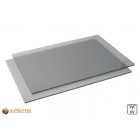 from €40.38 / m2
from €40.38 / m2Incl. 19% Tax
Polycarbonate sheets transparent custom cut (UV-stabilised)
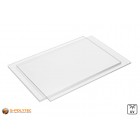 from €32.44 / m2
from €32.44 / m2Incl. 19% Tax
Transparent acrylic glass XT cut to size | S-Polytec
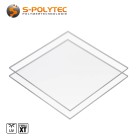 from €15.57 / m2
from €15.57 / m2Incl. 19% Tax
Acrylic sheets opal 5mm
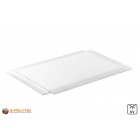 from €35.69 / m2
from €35.69 / m2Incl. 19% Tax
Hard-PVC sheets lightgray 2x1meter (UV-stabilised)
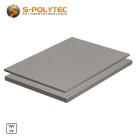 from €38.92 / pcs
from €38.92 / pcsIncl. 19% Tax
Hard-PVC sheets white 2x1meter (UV-stabilised)
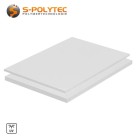 from €19.15 / pcs
from €19.15 / pcsIncl. 19% Tax
Rigid PVC White cut to size (UV stabilised)
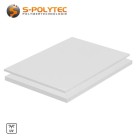 from €24.25 / m2
from €24.25 / m2Incl. 19% Tax
ASA/ABS sheets grey grained made to measure
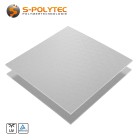 from €29.36 / m2
from €29.36 / m2Incl. 19% Tax
ASA/ABS sheets grey grained 2x1 meter
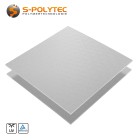 from €47.58 / pcs
from €47.58 / pcsIncl. 19% Tax
ASA/ABS sheets black grained made to measure
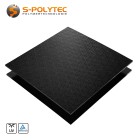 from €28.98 / m2
from €28.98 / m2Incl. 19% Tax
Trespa® Meteon® FR UNI COLOURS 2x1meter
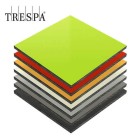 from €271.50 / pcs
from €271.50 / pcsIncl. 19% Tax
HPL sheets wood decor (dark ash)
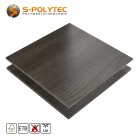 from €74.11 / m2
from €74.11 / m2Incl. 19% Tax
Plastic panels for outdoor use
Weatherproof plastics – the right panel for every equipment
Hardly any other material can be processed as easily as plastic. From simple cutting to size, to bending and thermal forming, there are almost no limits to the shaping of thermoplastics, to which our plastic sheets belong almost without exception. The simple processing and the various properties of the different plastics contribute to the fact that plastics cannot be dispensed with in outdoor applications. From rollers and handles on the ball grill, garden tools, furniture and toys, as well as swimming pools, terrace boards or terrace roofing. In every garden and on every balcony, weatherproof plastic is used in some way or another.
Especially in the construction sector, it is impossible to imagine the building industry without plastic, because it is inexpensive, light and durable. From window profiles made of rigid PVC, to transparent roofing for terraces and carports, to complete façade cladding, there is a suitable plastic sheet for every application.
The wide range of possible applications contributes to the fact that a whole range of plastics and even more plastic sheets in a wide variety of designs are available on the market. Of course, you will find an extensive selection in our online shop for almost every conceivable area of application. Whether transparent or opaque (opaque), whether flame-retardant or rigid, whether cut to size or as a standard panel - with us you always buy weatherproof plastic panels at the best possible price.
Typical applications for weatherproof plastic sheets
There is actually no industry that can completely do without plastics. In addition to the specific requirements for plastic, most industries also depend on weatherproof properties. From the construction sector, to the automotive industry, to playground equipment manufacturers, plastic is used almost everywhere where another material is too expensive or complex to process. Also the low weight and high durability compared to most other materials (e.g. wood, steel, aluminium, glass, etc) is often an important reason for choosing a weatherproof plastic.
- Acrylic glass and polycarbonate sheets are used as weight-saving glass substitutes for terrace roofs
- UV-resistant plastic panels are suitable as privacy protection for balcony surrounds or for façade cladding
- Durable patio furniture and window profiles are manufactured from weather-resistant plastics
- In the automotive industry UV-resistant plastics are used for body parts and interiors
- and much more
Our standard delivery programme for plastic sheets
- HPL boards in various colours, decors and thicknesses in cut to size
- Acrylic glass sheets in transparent, tinted or opal in various thicknesses, cut to size
- Polycarbonate sheets in transparent or grey tinted in various thicknesses when cut to size
- Aluminium composite panels in different colours and decors cut to size
- PE-boards black in UV-stabilised design in various thicknesses in cut to size
- PVC sheets in UV-stabilised version in various colours and thicknesses in standard format
- ASA/ABS sheets with grained ASA surface on one side in black or grey cut to size
- DecoVitas decorative panels in high-gloss white with or without self-adhesive cut-to-size
- PTFE sheets in various standard formats or cut to size in many thicknesses
Our extended delivery programme on request
- Acrylic glass sheets cut to size up to a maximum of 3050mm x 2050mm in various designs
- Polycarbonate sheets cut to size up to a maximum of 3050mm x 2050mm in various designs
- HPL panels cut to size up to 3050mm x 1300mm in various colours, decors or thicknesses
- Alu composite panels cut to size up to 3050 x 1500mm in various colours
- and many more
TIP: Please note that delivery times and shipping costs may vary for our extended delivery programme. On request we can, however, provide you with information about a possible delivery date at any time. The shipping costs depend on the specific requirements with regard to the size and total weight of an order.
Requirements for weatherproof plastic sheets
Plastic panels that are to be used permanently in outdoor areas must meet a whole range of requirements. These include not only the resistance to UV radiation but also the weather resistance or light fastness of a plastic. Often other factors that depend on weathering must be taken into account. These weathering influences can vary considerably depending on the specific application or place of use and country. In each individual case, it should therefore always be checked whether the desired plastic can cope with the ambient conditions or whether another plastic sheet might be better suited for the intended use.
If a plastic sheet does not meet the necessary requirements for the ambient conditions or does not do so sufficiently, this can cause premature ageing of the plastic. This can make itself felt, for example, through fading of the colours or reduction of the gloss level and can also result in changes in the mechanical properties. In the worst case, prolonged exposure to UV radiation or weathering can lead to material failure.
Weather resistance of plastics
Weather fastness evaluates the change in properties such as colour, degree of gloss or mechanical strength and elasticity due to the effects of weathering. This is where the term weathering stability comes from, which, in contrast to light fastness (light stability), does not only take into account the changes caused by the action of light rays. In addition to the pure exposure test, influences caused by certain weather situations also play an important role in weather fastness. These factors include maximum and minimum temperatures to which a plastic sheet should be exposed. The extent and speed of temperature fluctuations can also be of decisive importance when it comes to choosing a suitable plastic.
Rain or fog and the associated humidity, as well as mechanical stress caused by hail, heavy rain or wind are also among the factors caused by weather situations and have an impact on the evaluation of weathering stability.
-
weather resistance factors
- Temperatures and temperature fluctuations
- duration and intensity of light influence
- moisture (e.g. rain, fog)
- UV radiation (UV-A, UV-B, UV-C)
- mechanical load (hail, heavy rain, wind)
Weather resistance of plastics
Weather resistance is often used as an equivalent term for weather resistance. However, in addition to general weathering influences, there are a number of other factors that must be taken into account when considering the weather resistance of plastics, which are not influenced by the weather. However, the evaluation of weather resistance in combination with the evaluation of UV resistance already provides sufficient information about the weather resistance of a plastic.
In addition to general weathering influences, weather resistance is also assessed in terms of environmental influences such as atmospheric oxygen content, ozone pollution, relative humidity, effective UV radiation and air pollution by sulphur dioxide or nitrogen oxides. Each of these assessment criteria can vary greatly from region to region and contribute to the premature ageing of a plastic. In the Sahara desert, high temperature fluctuations between day and night are to be expected. In addition, UV radiation from sunlight must be rated as very high, while relative humidity there must be rated as very low due to the desert climate. In Germany (and most European Member States), on the other hand, the climate tends to be mild and humidity levels are much higher. Air pollution from road traffic and industry is also significantly higher in populated regions than in less populated regions.
-
factors of weather resistance
- Weather influences
- relative humidity
- UV radiation (UV-A, UV-B, UV-C)
- oxygen content in the air
- ozone load
- air pollution
Basically, plastic sheets with lower thickness are less resistant to environmental influences in connection with mechanical stress than plastic sheets of the same material with a higher thickness.
Light fastness of plastic sheets
Lightfastness is not primarily dependent on the type of plastic, but provides information about the durability or lightfastness of colours under the influence of brightness. Light in any form, but especially sunlight with a high proportion of UV light, is absorbed by surfaces and leads to colour changes. As a rule, this becomes noticeable by fading of the colours, which is why the term colour stability is often used synonymously.
As a general rule, there is no complete light fastness. Every colour loses intensity under the direct or indirect influence of light. Hue, colour saturation, colour luminance and material properties are also important factors for light fastness. The degree of colour change and the speed at which fading or yellowing occurs depends on the amount of light, the duration of light incidence and the proportion of UV rays, among other things.
The wool scale (or blue scale) is the most common method used to determine and evaluate lightfastness. This scale ranges from value 1 for very low light fastness to value 8 for excellent light fastness.
-
wool scale as a measure of lightfastness
- WS 1 - very low light fastness
- WS 2 - low light fastness
- WS 3 - moderate light fastness
- WS 4 - fairly good light fastness
- WS 5 - good light fastness
- WS 6 - very good light fastness
- WS 7 - excellent light fastness
- WS 8 - excellent light fastness
UV-resistance of plastic sheets
UV-resistant refers to materials and substances that can be easily exposed to UV radiation (ultraviolet radiation) without impairing their optical appearance or mechanical properties. Among other things, UV resistance prevents colour changes (discolouration, fading or yellowing), as well as embrittlement or cracking of the material. In addition, UV resistance helps to ensure that UV radiation does not reduce the elasticity, strength and hardness of the material.
UV rays have wavelengths of less than 380nm and are therefore not visible to the human eye. A distinction is made between UV-A, UV-B and UV-C radiation, which have different short wavelengths. The shorter or shorter the wavelength, the more energy the radiation has on the surface.
-
wavelengths of beams
- Visible light - approx. from 400nm to approx. 780nm
- UV-A radiation - from 315nm to 380nm
- UV-A radiation - from 280nm to 315nm
- UV-A radiation - from 100nm to 280nm
- X-rays - approx. from 0.01nm to approx. 10nm
As part of organic chemistry, plastics are particularly susceptible to ultraviolet radiation and therefore cannot be used outdoors without hesitation. Daylight, especially sunlight, contains a high proportion of UV radiation and causes photo-oxidation in plastics. This process produces so-called radicals which attack the plastic surface. The radicals break up the main chains of the polymer and incorporate various polar compounds such as peroxides. Put simply, the energetic radiation causes a splitting at the molecular level and results in the formation of microscopic cracks. The UV radiation passes through these microcracks and penetrates further into the interior of the material, thus permanently and irreversibly impairing the mechanical strength and chemical properties of the material.
Allerdings trifft dies nicht gleichermaßen auf alle Kunststoffe zu, so dass durchaus auch Kunststoffarten verfügbar sind, die aufgrund Ihrer chemischen Zusammensetzung eine gute Beständigkeit gegen UV-Strahlen aufweisen. Diese Kunststoffe werden als UV-beständig bezeichnet. Die energiereiche, kurzwellige Strahlung macht zwar auch vor UV-beständigen oder künstlich UV-stabilisierten Kunststoffen keinen Halt, so dass auch diese mit der Zeit unter dem Einfluss von UV-Einstrahlung beeinträchtigt werden. Allerdings sind solche Kunststoffe erheblich beständiger und halten der Strahlung deutlich länger stand, als Kunststoffe ohne UV-Beständigkeit. Zu diesen Kunststoffen zählen zum Beispiel Acrylglas oder PTFE.
-
UV-resistant plastics (and trade names)
- polymethyl methacrylate (PMMA, acrylic glass, plexiglass, set acrylic, etc.)
- Polytetrafluorethylene (PTFE, Teflon, Dyneon, Gore-Tex, etc.)
- acrylonitrile-styrene-acrylate copolymer (ASA, Polyformage Plus, Luran S, Centrex, Rhodapas, etc)
Additives are added to the granules to increase the resistance of plastics, which otherwise tend to have low or moderate UV resistance, to UV radiation. In most cases this is active carbon black, which acts as a UV absorber, absorbing the incident energetic radiation and converting it into heat. With a small quantity ratio of about 2% to 4% total, the basic properties of the plastic are not affected, so that a plastic sheet UV-stabilised by active soot has the same properties as a non-stabilised type.
-
Examples of UV-stabilised plastics
- Polyethylene sheets e.g. HDPE in black by adding active soot
- Window profiles made of rigid PVC sheets by adding titanium dioxide
- Unbreakable plastic glazing made of polycarbonate by adding benzophenones
- Reserved wheel covers of SUVs made of polystyrene (HIPS) are made UV-stable by adding active carbon black.
- and many more
In addition to the actual UV absorbers to improve UV resistance, other additives are often added to improve general weathering resistance. These may, for example, be antioxidants for heat stabilisation, because high temperatures also have an accelerating effect on the ageing process caused by UV radiation.
Frost resistance of plastics
Outside temperatures in our latitudes can fall below freezing point. For this reason, when choosing a suitable plastic, it should always be checked whether frost resistance is required for the intended use. Although most plastics are also suitable for sub-zero temperatures, not all of them are suitable for outdoor use. Even with weatherproof plastics, it is not always guaranteed that the temperature range of use will reach sufficiently far into the minus range. The best example for this are ASA/ABS sheets, where the temperature range is from -10°C to +90°C.
Für den Fall, dass ein Kunststofferzeugnis nicht im Außenbereich überwintern muss, wie zum Beispiel Gartenmöbel oder Kindespielzeuge im Sandkasten, kann man die Frostbeständigkeit des Kunststoffs mit Sicherheit vernachlässigen. Es gibt jedoch auch Anwendungen, bei denen schon vor der Verwendung geprüft werden sollte, ob die Temperaturbeständigkeit für die regional typischen Temperaturen ausreicht.
-
Examples for applications Plastics in permanent outdoor use
- Terrace canopies made of transparent or tinted polycarbonate (or acrylic glass)
- Plastic pipes, plastic rain gutters or plastic profiles for windows and roofing made of PVC-U
- Facade and wall cladding with aluminium composite panels, HPL facade panels or decorative panels
- Plastic bodywork components on cars, trucks, buses and trains, as well as in air travel
- Signs and information boards made of plastic or plastic composite materials (aluminium composite boards)
- and many more
Heat resistance of plastics
The heat resistance of plastics does not only refer to the actual warming caused by ambient temperatures, which even in this country can rise above 40°C in summer. All plastics would easily withstand these temperatures. Even the less heat-resistant polystyrene (HIPS) or polyvinyl chloride (rigid PVC or PVC-U) could be used at such temperatures without hesitation.
The warming caused by solar radiation has to be taken into account much more than the prevailing outside temperatures themselves. The colour of a plastic panel also plays a decisive role. The darker a surface is, the higher is the absorption of solar radiation. This in turn results in higher surface heating. Especially with very dark grey tones, such as anthracite or even black tones, the heating of the plastic surfaces can be much higher than the air temperature in the surrounding area.
Weitere Faktoren, die beeinflussen, wie stark sich eine Oberfläche durch Sonnenlicht aufheizt, sind unter anderem der Glanzgrad einer Kunststoffplatte, die Oberflächenstruktur oder die Wärmeleitfähigkeit des Werkstoffs. Auch die Lichtdurchlässigkeit trägt zum Erwärmungsfaktor bei. Je Lichtdurchlässiger ein Kunststoff ist, umso geringer heizt sich dieser effektiv durch Sonneneinstrahlung auf.
-
Factors that influence surface heating
- absorption coefficient of the surfaces
- emissivity of the surfaces (reflection)
- structural condition of the surfaces
- thermal conductivity of the material
- Cooling environmental factors (wind, rain, etc.)
In many plastics that are to be used for outdoor applications, heat stabilisers in the form of additives, added during production, prevent decomposition at higher processing temperatures.
Thermal expansion of plastic sheets for outdoor use
In addition to the actual continuous operating temperature to which a plastic material can be exposed, the thermal expansion of a plastic panel is sometimes a decisive factor for professional installation. Especially in the case of large areas of façade cladding or terrace roofing, the possible change in size due to temperature fluctuations must be taken into account. In the case of HPL panels for balcony cladding or as façade cladding, for example, this is achieved by means of a constraint-free installation using fixed and sliding points.
How much a plastic sheet expands depends primarily on the coefficient of thermal expansion of the respective plastic. The actual temperature and the size of the surface must also be taken into account when calculating the linear expansion due to heat. The characteristic value of the specific coefficient of thermal expansion is subject to a precisely defined measuring procedure at room temperature (20 °C), which is defined in DIN 52328 - "Determination of the average thermal coefficient of linear expansion", among others.
Transparent acrylic glass, for example, has a linear coefficient of linear expansion of 0.065mm/m/°C. This means that a plastic sheet with the basic dimensions of 1m x 1m expands by 0.065mm in both length and width when the temperature is 1 degree Celsius above the standardised test temperature of 20°C. At an outside temperature of 25°C, the linear expansion in our example is already 0.325mm.
-
Factors for calculating thermal expansion
- coefficient of thermal expansion of the plastic
- Temperature to determine thermal expansion
- dimensions of the plastic plate
- thickness of the plastic sheet
TIP: It is not uncommon for the coefficient of linear or thermal expansion to be given in millimetres per Kelvin. Even integer values with negative powers of ten are not uncommon in data sheets among the thermal properties for linear expansion. Here it may be necessary to convert the temperature units and/or length units to determine a possible linear expansion at a certain temperature.
Temperature application ranges of plastic panels for outdoor use
Not all plastics can be used in the same way when exposed to low or high temperatures. Especially when it is hot, the temperature range for plastics usually reaches the 100°C mark before the plastic sheet begins to soften. We have summarised the temperature range of our weatherproof plastic sheets in a small overview table.